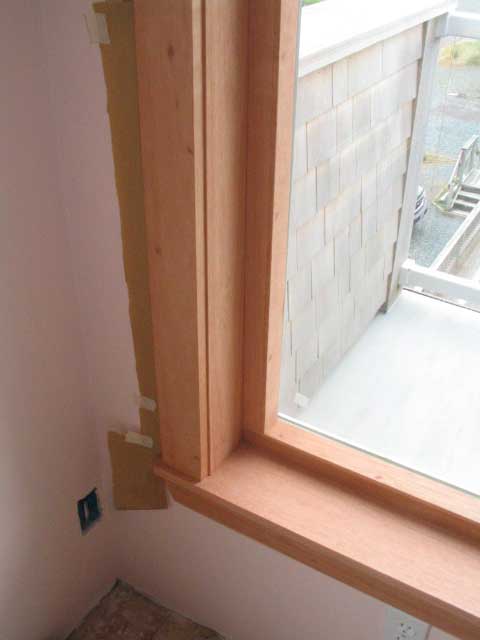Question
At the client's request to hide the vinyl, I have, somewhat painstakingly, built the window jams and casings below, all from clear, vertical grain, kiln dried mahogany, that has a strong red hue. The customer would like to keep this hue, does not wish to stain it and would like to use a gloss finish. I need to use a finish that is strong and can withstand spilled water, fingerprints and scrubbing. Also, there is to be no spraying.
I did several samples, and although it darkens the finish, the customer does like the gloss urethane. Question: because this is a clear, unstained finish, would anyone consider sealing the mahogany first? I considered shellac and brushing lacquer, but I don't think the finish would hold up very well. Does anyone have an other clear finish suggestions?

Forum Responses
(Finishing Forum)
From contributor M:
To use the Polyurethane as a sealer, reduce it 50%, and then apply it, allow it to dry, sand if needed, and then go to your regular Polyurethane coatings.
I have been making a clear 2K polyurethane finish for almost twenty years. My customers who have put my finish, Five Year Clear(tm), on the exterior teak trim on their boats (and had their boats in San Diego, CA or Ensenada, Mexico) have reported back to me that "the gloss went between the eighth and ninth years and the color of the wood still looked good."
The performance comes with a price, though. It's not the easiest to apply or repair, it's expensive, and you have to pass a checkout by me on the instructions before you can apply it. In many interior applications there are other perfectly adequate finishes where extreme weathering and ultraviolet endurance is not an issue.
There was mention of the issue of staining wood, and I'd like to comment on that. Wood is some shade of brown, and all shades of brown can be matched with only black, white, red and yellow. Some stain manufacturers use dyes and light-unstable pigments that drift with ultraviolet exposure. Sadly, these will not give good performance unless protected with a topcoat that has extraordinarily good ultraviolet absorption. I recommend that you test your own stain - put some on a piece of wood, cover half with aluminum foil and put it outside for a week. Then remove the foil and look at the difference.
As for staining mahogany, this is done with antique and classic boats to give a uniform color tone to the wood. To do this you need to sand with 80-150 grit parallel to the grain, wipe on filler stain, wipe it off with cheesecloth perpendicular to the grain. Finer grits of paper give less stain deposited and thus less color added to the wood. A topcoat with a considerable amount of ultraviolet absorbers, applied in an adequate film thickness is necessary as a topcoat. For the typical marine varnish, budget a pint over each ten square feet, regardless of how much reducer is used or how many coats it takes. Use up a pint, minimum, over each ten square feet.